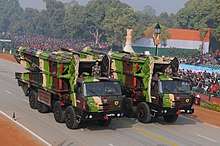DRDO Sarvatra
The DRDO Sarvatra also known as Sarvatra Multi-span Mobile Bridge System is a truck-mounted, multi-span, mobile bridging system developed by Armament and Combat Engineering Systems (ACE) and Research and Development Establishment (R&DE) Engineers of Defence Research and Development Organisation (DRDO)[1] for the Indian army. Its nodal production agency is Bharat Earth Movers Limited (BEML), Bangaluru.
| Sarvatra Bridge System | |
|---|---|
 Sarvatra Bridging System at Republic Day | |
| Type | Armored vehicle-launched bridge |
| Place of origin | India |
| Service history | |
| In service | 2000–present |
| Production history | |
| Manufacturer | BEML Limited Dantal Hydraulics Defence Research and Development Organisation Larsen and Toubro Oscar Equipments |
| No. built | 5 |
| Variants |
|
| Specifications | |
| Length |
|
| Width | 4 m (13 ft 1 in) |
| Height | 2.6 m (8 ft 6 in) to 6 m (19 ft 8 in) (adjustable) |
| Crew | 4 |
| Engine | TVML T 3-B / T 3-C series V8 turbocharged multi-fuel with intercooler 235 horsepower (175 kW) to 368 horsepower (274 kW) |
| Payload capacity | 1× scissors-type folding bridge (22 tonne) |
| Transmission | Non-synchronized manual, 10 forward + 2 reverse gears |
| Suspension | Leaf spring and air suspension with telescopic shock absorbers |
Operational range | ~800 km |
| Maximum speed | 80 km/h (50 mph) to 90 km/h (56 mph) |
Description
The Sarvatra is a 75 meters long multi-span mobile bridging system consists of five scissors bridge made of aluminum alloy having span of 15 meters each mounted on separate mobile platform. Each mobile platform is a modified Tatra T-815 VVN 8 x 8 chassis drive-able from both ends by having an additional small cabin with required driving controls. Further a microprocessor based control system is utilised to deploy and operationalise the entire system in less than two and half hours.
When the 15 meter long scissors bridge is opened out it is fitted with adjustable trestles to enable a number of units to be used to bridge wet and dry gaps. All five sections are laid to provide a total bridge length of 75 m providing a roadway of four meters. The bridge is launched/recovered from either end. With the help of telescopic legs, the height of the bridge is adjusted from 2.5 m to 6 m so that it is not easily visible from far.
The Sarvatra project was sanctioned in 1994 and completed development in October 1999 at a total cost of Rs 230 million. It was approved for production in March 2000 after trials. The Sarvatra will replace the East European PMS Bridges, in service of Indian army which require 57 Tatra vehicles to bridge 100 metres. In contrast, the Sarvatra, with just five Tatra trucks, bridges 75 metres. At Rs 600 million per set, the PMS costs almost thrice as much as a Sarvatra.
A 20 m variant of Sarvatra bridge system capable of bridging a gap of 100 meters have also been developed.
Operators
- Indian Army : 110 units (22 sets) of 15M Sarvatra Bridge System variant on order.[2]
Specifications
- Load Class: MLC–70
- Single Span Length:
- 15 m
- 20 m
- Multi-Span Capability:
- 75 m
- 100 m
- Roadway Width: 3.45 m during transportation; 4 m during use
- Span Height: 2.6 m to 6 m
- Construction time: 150 minutes
- Crew: 1 specialized driver + 3 combat engineers
See also
References
- "Multispan Mobile Bridging System (SARVATRA)". Defence Research and Development Organisation. 11 March 2020. Retrieved 11 March 2020.
- PSU Connect. "BEML Limited hands over 15 M Sarvatra Bridge system to Indian Army". PSU Connect. PSU Connect Media Private Limited. Retrieved 10 March 2020.